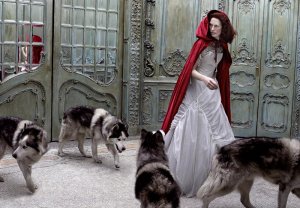The True Story of Little Red Riding Hood

Most of the stories left to us both by the Brothers Grimm and Charles Perrault were taken from local legends and traditions throughout the Middle Ages as they traveled through the villages of Europe. Many of them reflect the psychology of the period, their beliefs, their myths… all of them rooted in testimonies that wrapped them up in a certain “magical realism.” One of the oldest and maybe the most remarkable stories can be found in the tale of “Little Red Riding Hood.”
According to experts, this story is one that has undergone the most transformations since its origins, these changes always having the intention of “softening” some images so that a young audience could calmly listen to it. But the truth is that with every change, we lost the original intentionality, because every story contained a doctrine, a lesson that we should all follow. And the one taught to us by Little Red Riding Hood is worth keeping in mind…
Charles Perrault and the Brothers Grimm
Charles Perrault was the first to collect the story of Little Red Riding Hood in 1697. He had to include it in his collection of popular stories although it was one of the least known for the European population. Certain images were so brutal that he changed them in order to make it suitable for a young audience. This was the first time that the story of this young girl with her red cap made its way to Europe.
In 1812, the Brothers Grimm also decided to include her in their collection. In order to do this, they drew upon a work by the German Ludwig Tieck entitled “Life and Death of Little Red Riding Hood” (Leben und Tod des kleinen Rotkäppchens), which includes – unlike Perrault’s story – the character of the hunter. They removed every trace of erotic and bloody elements and gave the story a good happy ending. Because what would a child’s story be without its customary happy ending? As you can already guess, the original story is very different from the one that children read in their books, so let us get to know it.
The story of the real little red riding hood
As we pointed out before, this story finds its origins in an isolated region in the Alps. The goal of the story is to warn us, to show us that there are forbidden things for our community as a human race, a community, and a group. In the legend, our protagonists are an adolescent, a young girl who has just entered the adult world, as well as her red cap, a symbol for menstruation.
This young girl gets an order from her family: you have to go across a forest to get to take bread and milk to your grandmother. As you can see, up to this point, the variations with the original story are not too great, but we have to interpret each gesture and each image. The forest is danger, a risk zone for young people and one that is rises up as a test, as the rite of passage for a community, with which to show that a person’s children have now entered the adult world.
The main risk of this forest comes in the form of the wolf. This animal symbolizes wildness and the irrational. Something that our Red Riding Hood already knows and that she must face. The young girl manages to cross the forest and happily enter the house of her grandma, who receives her in bed because she is sick. All of this is very similar to our classical story, no doubt, but here come the changes…
The grandma tells the girl to keep the bread and milk and to eat the meat that is prepared in the kitchen for her. Red Riding Hood agrees and devours it hungrily and feels full. After this, she obeys her grandma’s next order: she must take off her clothes, piece by piece, and burn them in the future, then to lie down in bed next to her. The young girl agrees, curious, but without doubting for a moment, without thinking about how weird the situation is, because just as she is going to lie down in the bed, she discovers that it is the wolf who is receiving her between roars of laughter, informing her that the meat that she has just eaten is her grandmother’s flesh. She has committed a horrible sin, cannibalism. Later, the wolf devours Little Red Riding Hood.
The symbolism is implicit in each character: The wolf is the sexual and violent world. The old woman who is devoured by a young girl, thereby replacing the old with the new, while at the same thing the new is presented as foolish and naïve for committing one of humanity’s greatest sacrileges: cannibalism. As you can see, one of the most classical and beloved stories from our childhood in fact has a very dark side.
This text is provided for informational purposes only and does not replace consultation with a professional. If in doubt, consult your specialist.








